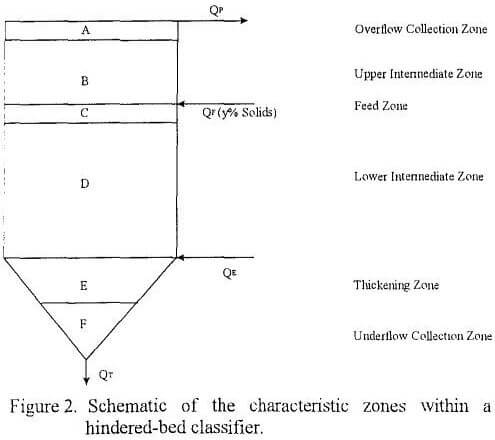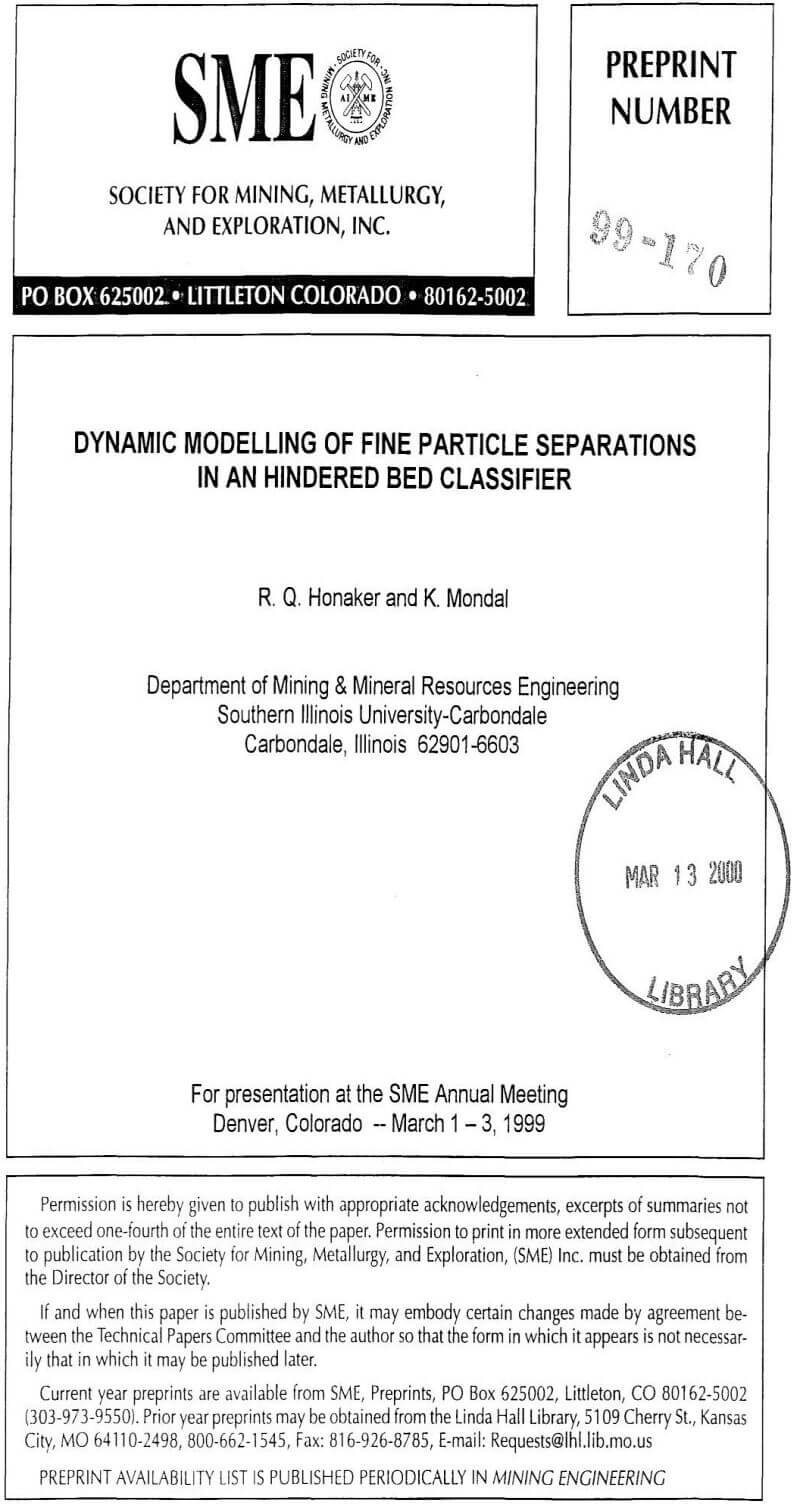Significant research has been conducted in the past to evaluate the application of hindered-bed settling devices for achieving efficient particle size classification. However, recent studies have been devoted to the interest of using the hindered-bed devices as gravity-based separators for multi-species suspensions having wide density differences between the various particulate components. The ability to achieve density separations is based on the fluidization of the heavier particles in the suspension using an upward current of water, thereby creating a high-density particle bed. Only particles having sufficient mass can pass through the bed and report to the underflow stream. Thus, the fluidized particle bed is an autogenous medium that facilitates a separation based on differences in particle density.
Littler (1986) evaluated the effect of hindered-beds on the classification and beneficiation of minerals and found that throughput capacity and teeter water requirements are a function of the particle size distributions of the mineral components being separated. McKnight et al. (1995) found that a commercial hindered-bed unit known as the Floatex Density Separator was very efficient in the recovery of zircon from wet gravity tailings. A classifier commercially known as the allflux Separator has been found to provide excellent purification of quartz sand, iron ore and heavy minerals (Grotjohann and Snoby, 1998).

The cleaning of fine coal using hindered-bed classifiers has also been the subject of several recent investigations. Mankosa et al. (1995) conducted tests using a hindered-bed classifier as a pre-cleaner to spiral concentrators for the treatment of a difficult-to-clean coal. The findings suggest that the hindered bed-spiral combination provides an efficient, low density separation that allows the production of clean coal while maintaining a relatively high recovery of combustibles. Studies comparing the separation performances achieved by spiral concentrators and two hindered-bed classifiers (i.e., Stokes and Floatex) found the classifiers to provide more efficient gravity separations for nominally 1 mm x 150 µm coal (Reed et al, 1995; Honaker, 1996). Nicol and Drummond (1997) have described the efficiency of hindered-bed density separators and several fine coal circuits for which application may prove to be beneficial. In fact, Drummond et al. (1998) recently reported on the optimization studies conducted on a 75 tonne/hr hindered-bed classifier installed in an operating coal preparation plant in which the separator is being used as a cleaner unit for the spiral product. This application reportedly allows separation densities (d50) below 1.6 and probable error (EP) values in the range of 0.10 to 0.15.
The fundamental concepts of hindered-bed classifiers have been well described in previous publications and the mechanisms are well understood. However, complexity in the operation of the classifiers is realized due to the extensive interactions of the operating parameters and the resulting impacts on separation performance. To assist in the understanding of the operation of a hindered-bed classifier, a dynamic population balance model has been developed and validated with experimental results obtained from an in-plant study. The model development, validation and simulation results are described herein.
The specific hindered bed classifier that was modeled in this study is commercially known as the Floatex Density Separator. The portion of the Floatex above the teeter water addition point is 0.45 x 0.45 m² and is 1.5 m in height. The conical portion below the teeter water addition point is 0.75 m in height. The feed is injected through a manifold in the center of the cell at approximately 0.60 m for the top of the overflow weir. Teeter water is employed at the top of the conical portion through small holes placed along the length of several hollow bars placed in parallel at equal horizontal separation distances. The teeter water injection holes face downward to allow good water distribution and minimize turbulence in the teetered bed. Tire fluidized particle bed level is maintained at the desired value by monitoring bed pressure with a pressure transducer and providing a correspondingly appropriate underflow discharge rate through a control valve.
The experimental values needed to validate the model were obtained by operating tire Floatex unit in a coal preparation plant located in southern Illinois, USA. The preparation plant treats bituminous Illinois No. 6 coal extracted from an underground mine using longwall technology. The hindered-bed unit was placed in parallel with spiral concentrators used to treat the nominal 1 mm x 150 µm material. The feed rate was varied in the tests by diverting one, two, or three spiral starts to the Floatex. An experimental program based on a Box-Behnken statistical design was conducted on the unit to evaluate the effects of three operating parameters, fire operating parameters and their respective range of values tested are provided in Table 1. The particle bed level represents the distance from the top of the cell. The feed solids concentration during the tests was approximately 30% by weight.

